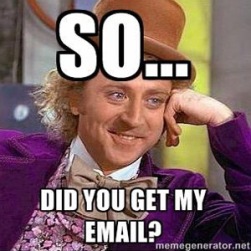
SPAM! and the customer is gone…
spamspamspamspamspamspamspamspamspamspamspambaconspamspamspamspamspamspamspamspam… etc
Spam -_- a word we all associate with annoying emails and advertisements, useless junk we don’t want and people trying to scam us online! Or simply the scrumptious looking canned meat in the famous Monty Python sketch…
This is a topic that digital marketers need to understand as most spam is actually illegal, and on top of that it annoys the viewers! Thankfully my email account filters the content and my spam ends up in its own folder, slowly multiplying and being ignored, but I don’t have to worry about sifting through hours of emails that turn out to be junk!
Whist consumers may say “OMG this person keeps spamming me/I’m being spammed by this company”, this is often an inaccurate and over-exaggerated exclamation. Officially spam can be defined as unsolicited commercial email and related undesirable online communication ( Rao and Reiley, 2012). Advertising, whilst it may be a nuisance and irrelevant to consumers, is different to spam in that the user has no option to opt out of it, there is no benefit and it is completely unsolicited. The point is, advertising is just something we have accepted as part of the package for using/viewing services and content.
As you can see in the screenshot to my left, the spam has clearly been seperated into its own category. The email providers want users to be satisfied so destroy the spam problem for us! Gmail as well divides its emails into ‘Primary’, ‘Social’, and ‘Promotions’ sections. The promotions inbox is not actually spam, as these are from brands that I have subscribed to and allowed for them to send me emails on updates, new products, sale information etc. Most of these are fashion brands and at any time I can unsubscribe from their email list and stop receiving the messages. So this is not spam. The spam sitting in my inbox is something I have no control over, and whilst I may not bother to read all (or most) of the promotional emails, I accept them and they have certain relevance to me. Any brands that I would find in my Spam inbox are undesired and most likely useless or dangerous (a scam) and there is no way to prevent there communication! In addition, the actual advertisements at the top of my promotions list (Energy Australia) are not ones I have asked to receive communication for but are paid advertisements that still have the ‘x’ icon allowing for me to close their promotions.
Is it allowed?
The Spam Act (2003) was created to prevent invasive content and to guarantee that businesses aren’t spamming their consumers with a few simple regulations. The Spam Act states that emails must not breach (ACMA, 2015):
- Consent: consent must be clearly provided by consumers prior to receiving an email;
- Identify: the email sender must be easily identifiable;
- Unsubscribe: receivers must be presented with an unsubscribe link to cease receiving emails from this sender.
Don’t be fooled by scammers, if it doesn’t seem legit, it probably isn’t! Know your source and check that there is a way to opt out of communications.
Social media opens the window for all sorts of communication and spamming, so be careful. If you’re unsure, check out how to identify and prevent spam.
On the other side of the coin, marketers need to understand how to not spam! If you a marketer here is some advice on avoiding spamming your consumers. There are 5 simple steps to increase deliver-ability
- Avoid spam words! ($$$$, Bargain, Cash, Earn, Easy terms, etc.) These are all suspicious!
- Don’t look spammy! (The colour red, multiple links, confusing subjects, overload of symbols, etc.)
- Choose the right service provider! (With a credible and positive track record)
- Certify your IP! (Email providers will like you better)
- And common sense!
Hope these tips help you to avoid spam/spamming!
What are your thoughts on spam?
How do you identify spam?
What types of spam do you receive most often?
Do you notice spam on social media as much as in emails where they are usually clearly filtered?


